Zenbivy Light Bed 25° Bundle
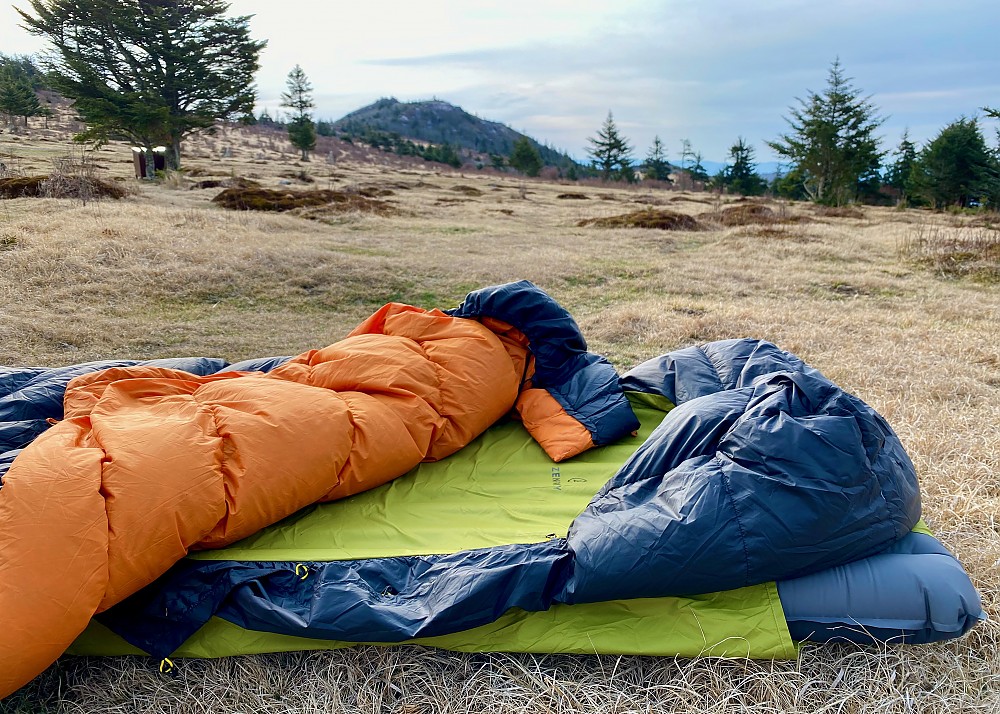
Everything you need for a stellar night's sleep in the backcountry! The Zenbivy Light Bed 25˚ Bundle provides a hybrid sleeping bag—a capacious quilt and hooded sheet that integrate with an air mattress—that provides various options for users to regulate mobility and temperature regulation. Great for side sleepers, those who move about while sleeping, or anyone seeking a cozy night's sleep without the confinement of a mummy bag.
Pros
- Comfortable and cozy backcountry sleeping
- Flexible configurations allow excellent temperature regulation
- High-quality materials and refined design
- Lots of comfort for the weight
Cons
- Configurations are initially a bit tricky
- Price may be out of reach for some consumers
- Ultralighters may balk at weight

On the company website, Zenbivy shares its reason for being: “Zenbivy was founded with a clear mission to create the most comfortable outdoor bedding the world has ever seen.“ To achieve that end, the company produces a line of beds, quilts, and mattresses with associated accessories, everything from the regular Zenbivy Bed to the Light Bed reviewed here as well as a MotoBed for car campers or a Double Bed for couples. The company, then, appears to have been founded to serve the backpacking community, but, as sleep systems are essential to any traveler away from home, Zenbivy's product range appears to have expanded to address not only backpackers but also car campers, overlanders, van lifers, or other travelers.
Zenbivy's roots, though, remain firmly in the backcountry. The company is relatively new, having been founded in 2017, but its founder, Michael Glavin, has worked previously with MSR, GSI, and Sierra Designs (according to the Zenbivy site, Sierra Designs Backcountry Bed and Backcountry Quilt were Glavin’s inspiration). Glavin had been on a personal quest for a mummy bag alternative for fifteen years before founding Zenbivy.
The Zenbivy Light Bed 25˚ Bundle
The Light Bed is what Zenbivy calls “a two-piece sleeping bag,” a hybrid sleeping bag—one that integrates with its mattress—that consists of a sumptuous top quilt and a hooded “sheet” with “wings.” The bundle I tested includes the following items, each also sold separately (please note that there are sizing and color options for all parts of the bundle except the pillow, for which there are only color options; see "Sizes and Colors," below):
- The Zenbivy Light Bed (Light Quilt + Light Sheet, both 25˚ as tested) with mesh storage sack
- Light Pillow (with drawstring storage pouch)
- Light Mattress (with Small Dry Inflation Sack)
- Dry Sack 7L
- Compression Caps (for Dry Sack)
The sheet attaches to a sleeping mattress, not with zippers (like the Zenbivy Bed), but with hooks; the quilt, in turn, can fasten in various configurations to the sheet to allow greater or lesser degrees of warmth and wiggle room that could not be provided with zippers. The hood of the sheet is insulated, matching that of the quilt.
The result is a flexible system in which one can choose how securely or how loosely one wants to attach the top quilt to the sheet depending on one’s needs for warmth or one’s desire for mobility. The mostly rectangular, slightly trapezoidal quilt can be left completely flat, or it can be secured for “mummy mode,” or attached to the sheet for “wide mode,” which offers more foot room.
Sizes and Colors
The Zenbivy Light Bed 25˚ comes in four sizes that are listed as Regular 20 x72, Large 20x72, Large 25 x 77, and XL 30 x 80. Full details about sizing, including both Imperial and Metric measurements, can be found on Zenbivy’s useful sizing guide accessed via the linked page.
The Light Bed currently is offered in three color options: green/teal, black/red, or green. The Light Pillow comes in a choice of green, red, or teal while the Dry Sack comes in 7, 10, and 15 L and a choice of Fire Red, Mango, and Deep Sea Blue.
Using the Light Bed Bundle
I tested the Light Quilt XL 25˚ (includes mesh storage bag) with the Light Sheet 25˚ and the Zenbivy Large Light Mattress (rated R5+; it comes with the Small Inflation Dry Sack). Completing the tested gear was a Zenbivy Light Pillow and some accessories: the Zenbivy Dry Sack 7L to carry the quilt and sheet in the field, and the Compression Cap to cinch down the Dry Sack into a compact package.


The assembly of the Light Bed becomes quick and intuitive after a few uses. I’ll describe how it is used subsequently, but if you prefer a video, you can watch the overview of its assembly below. I also recommend Zenbivy’s Assembly Instruction video (Note: their video features an older, two-strap iteration of the Light Sheet; Zenbivy is in the process of updating its videos).
- The Light Mattress is the base of the system, and the 25 x 77 in/63 x 196 cm model I tested provided 3 in/8 cm of cushion from the ground. It is made of 20d polyester taffeta. Within, it features “180g of fully baffled synthetic insulation” that earns it an R-value of 5+, making the mattress suitable for four-season use.
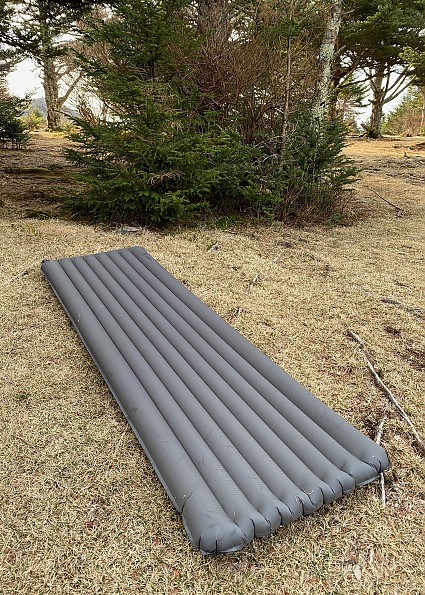
- The Light Mattress is inflated with its storage bag, the Dry Inflation Sack. The 6.5 in /16.5 cm diameter sack has a nice, long body (23.2 in/59 cm) that can trap a lot of air for swift mattress inflation. Even with the sack partially full, I inflated the mattress to full thickness with about 7 to 9 air refills of the sack in around a leisurely 3 minutes. I’m sure I could inflate it quicker with fewer refills if push came to shove.

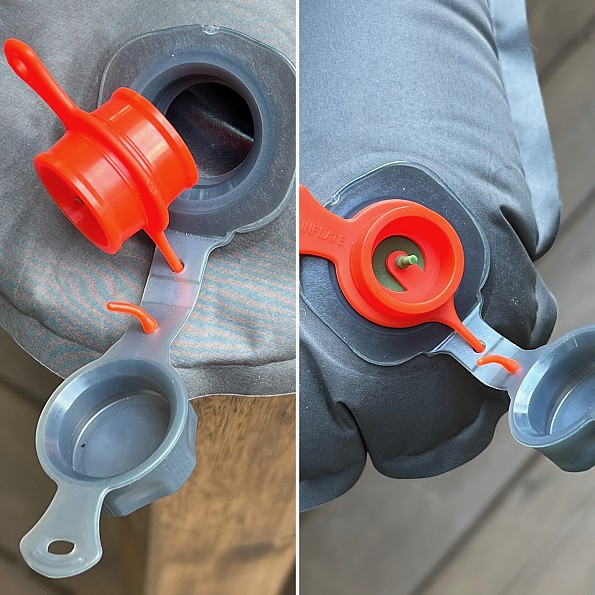
- The Light Sheet 25˚stretches onto the mattress with cut-out corners accommodating the mattress’s corners and a lightweight strap and buckle securing the sheet beneath the mattress. Zenbivy notes that it is “designed to fit most mattresses on the market including both rectangular and tapered styles” but recommends pairing it with a Zenbivy mattress to ensure the best fit. The sheet includes the “wings” that wrap around the sides of the quilt, ensuring cozy warmth and no draftiness as well as the capacious 800 fill-power HyperDRY down hood. Color-coded loops and hooks line the wings and edges of the sheet to allow the Light Quilt to be secured to it. Note: the most recent iteration of the sheet appears to come with a storage pocket in the hood for a phone, keys, or the like. My test model did not have this feature. Zenbivy has also since released a Fast Sheet that is half the length of the Light Sheet 25˚ with a non-insulated hood.


- Tucking into the hood is the Zenbivy Light Pillow, a two-piece pillow that comes with a small stuff sack. The first part of this featherlight 2.5 oz/ 70.8 g pillow is a polyurethane air bladder with a “push-button slow deflate valve” that allows one to adjust the degree of inflation to suit one’s own desires. This bladder is covered in a soft 50d polyester Pongee pillowcase that is slightly oversized to allow one to add additional cushioning such as a down jacket for really sumptuous sleeping. It nestles within the sizable hood, keeping it from wandering.
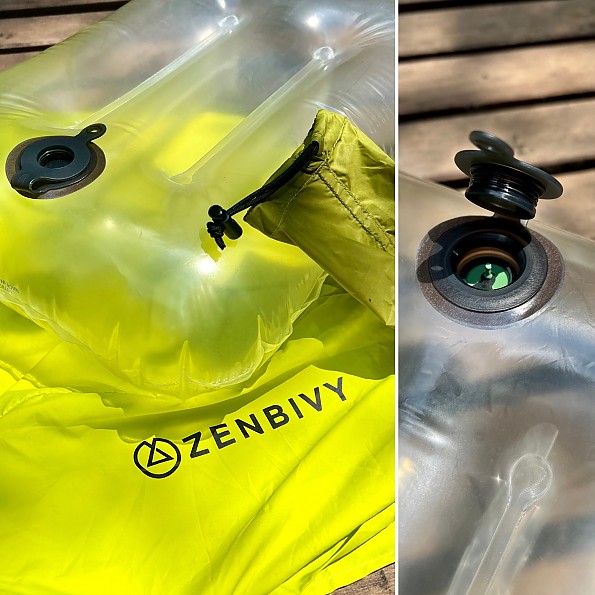
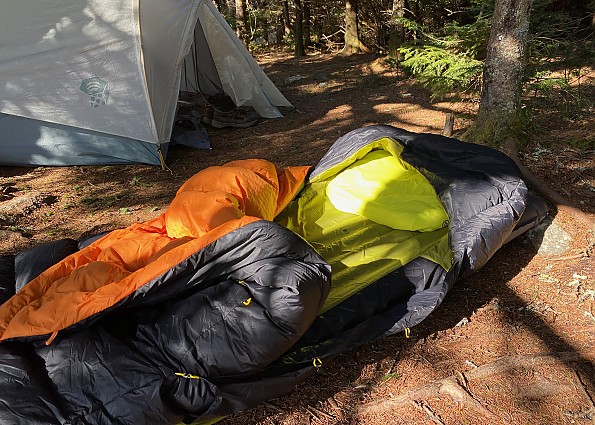
- Finally, the Light Quilt 25˚ completes the bed setup. It comes with a mesh storage sack for home storage; with the bundle, it comes with the Dry Sack 7L and Compression Caps (more on these shortly). This 800 fill-power HyperDRY down quilt features both horizontal and vertical baffle construction to minimize any migration of the insulation. Made of 20d nylon taffeta, the quilt is soft, comfortable, and undeniably cozy. At 6’2” 240 lbs, I tested the XL, which is 90 x 64 in/ 229 x 163 cm. The top edge of the quilt features the “Kylie Curve,” a “a 3/4-length baffle-backed drawstring” that cinches the middle of the quilt around your neck while allowing the edges to remain ungathered to drape about one’s shoulders. On the sides and bottom of the quilt are color-coded loops and hooks that allow the quilt to be fastened up in mummy mode for the warmest sleep or in “wide” mode for a roomier sleep. Leave the bottom open for “flat mode.” There is even a “rectangular mode" option. To help one navigate the how-to’s, Zenbivy has excellent directions in their online owner’s manual and their Assembly Instructions video.
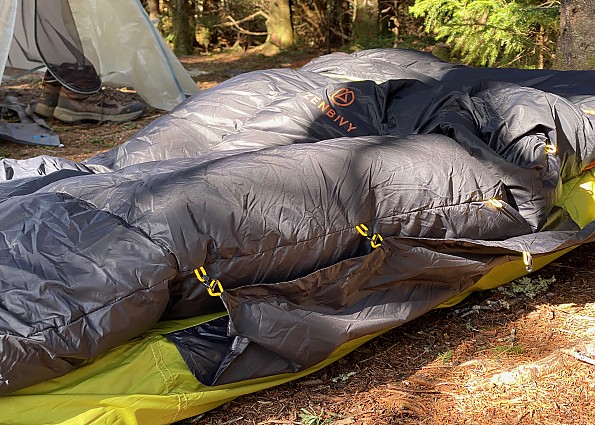


- A word on the Dry Sack 7L and the Compression Caps: The welded Dry Sack is tough and compact. It allows one to take advantage of the compressible down of the Quilt and Sheet and squish that insulation into a compact bundle that will keep the insulation dry. With the Compression Caps applied over the ends of the Dry Sack, the valve works well, releasing air as the compression straps are cinched down to reduce the dry sack’s displacement to something about the height of a Nalgene and about two times a Nalgene’s diameter.
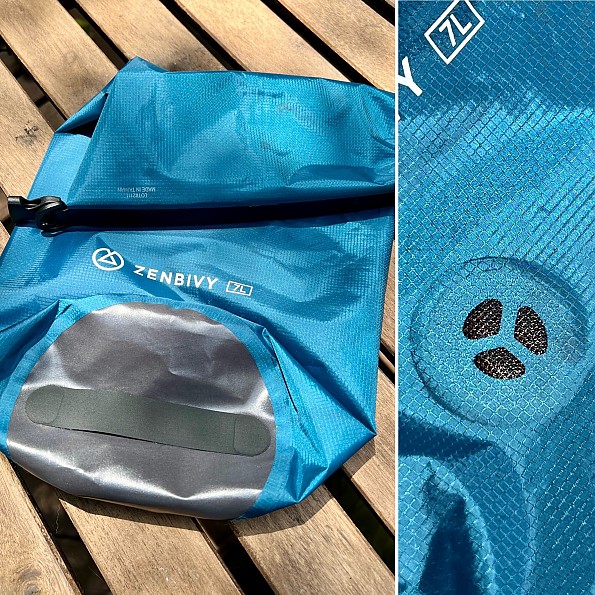


Observations and Use
Let me begin with a word on quality and design. The Zenbivy website suggests a relentless drive to perfect their products. The original Zenbivy Bed features zippers; these were dropped on the Light Bed to save weight and add greater flexibility to the sleep system. As I grew more accustomed to using the Light Bed, I began to appreciate how much thought and research must have gone into the design of this backcountry sleeping option. This system is well-engineered by folks who obviously have spent many nights outdoors and who prioritize comfort.
The engineering carries over into top-notch materials and manufacturing. The fit and finish of the Zenbivy products are excellent. The sewing and seams are neat and precise. The 800 fill-power down (actually rated at 802 fp on trackmydown.com) is HyperDRY water-resistant down, responsibly sourced (Responsible Down Standard compliant). The quilt is baffled, not sewn-through, to preserve the down’s loft. It is made of silky 20d nylon taffeta fabric for a soft skin feel.

The cordage for the attachment loops is the perfect diameter to catch on the hooks just enough to discourage them from coming loose unintentionally while still clipping in easily. The hooks themselves (listed as Nifco HND5L, HND7) appear to be made of strong, durable resin. The Inflation Sack and Dry Bag are made of light but sturdy materials (30d ripstop nylon body, 75d Polyester bottom) with fully welded construction; the Dry Sack also features a high-speed mechanical valve to allow air out while retaining waterproofness. Every detail of every piece of gear seems to be intentional and well-conceived.

Testing the Temperature Rating
How does the flexibility of the system play out in actual use? Below, I've indicated some temperature ranges as well as how I used the system components:
- In temps close to freezing or slightly below: Light Quilt, Light Sheet, Light Mattress, Light pillow; quilt in mummy mode and almost fully secured to the sheet for maximum warmth.
- In temps from about 40˚ F/ 4.4˚ C to around 55˚ F/ 12.7˚ C: Light Quilt, Light Sheet, Light Mattress, Light pillow; quilt in wide mode and partially secured to the sheet for more room.
- In temps 60˚F/ 15.5˚ C and above: Light Quilt, Light Sheet, Light Mattress, Light pillow; quilt open and unsecured or only lightly secured to the sheet to permit arms, legs, or trunk to be exposed to the air until the night cooled enough to merit more than a touch of quilt. On the warmest nights during testing (upper 60s to low 70s F/ 20˚-22.4˚ C), the quilt was simply within reach in case I felt a chill in the early morning hours (I sleep warm and prefer cool sleeping temps).
I received the Zenbivy Light Bed 25˚ Bundle in the early spring and promptly headed to southwest Virginia to test the system’s temperature ratings in the meteorologically unpredictable environment of the highland balds and spruce-fir forests around Mt. Rogers, Virginia’s highest point. The Light Bed 25˚ has a limit rating of 25°F/ -4°C and a comfort rating of 35°F/ 2°C.
My first night in the high country plunged below freezing, but I stayed warm in mummy mode (after a Kylie Curve adjustment) despite awakening to frost everywhere outside my tent (Note: I tend to be a warm sleeper and slept that night in a single long-sleeve, full-leg baselayer). In the coming months, I tested the Light Bed Bundle on several overnight trips in western and central North Carolina as well as logging more than two weeks of nightly sleeping with it in my backyard to test different quilt configurations in temperatures ranging from about 35˚F/ 2˚ C to the low 60s F/ 15.5+ C, a range I didn't experience during my backcountry trips.
The flexibility of the Light Bed’s hook and loop design became fully apparent in the wildly variant early spring (and later early summer) nights. As the coldest nighttime temps rose from the 30s and 40s F/ -1˚ to 9.4˚ C into the 50s and 60s F/ 10˚ to 18˚+ C, I switched from the close warmth of the mummy mode to the more spacious wide mode. I undid clips along first one and then both edges at the foot end of the quilt (flat mode) so that I could kick out a leg or two to regulate my temperature on the warmer nights.
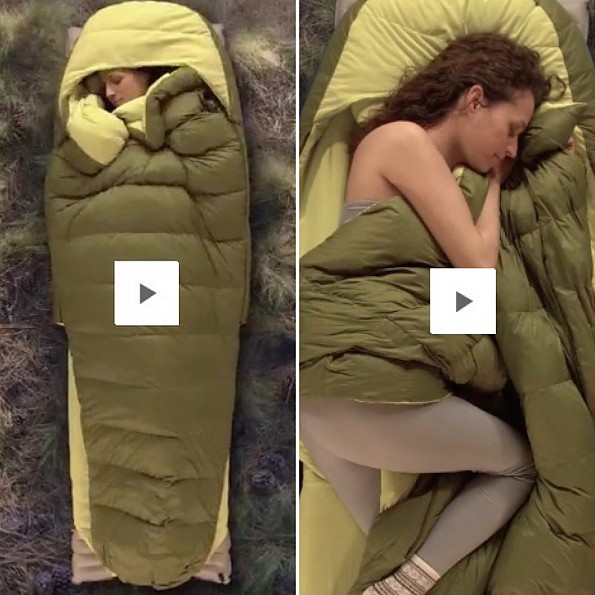
In early summer, I often left the quilt off at the start of the night (a few hooks kept it close), pulling it over me as temps dropped toward dawn. I found the quilt to be generally too warm as the temps rose into the upper 60s F/ 18.3˚+ C, but then this range is really more applicable to the Zenbivy Light Quilt 40˚ Synthetic (Limit: 40°F/ 4°C, Comfort: 50°F/ 10°C). From the 30s to the 60s F/ -1˚ to 18˚+ C, though, I found the flexibility of the Light Bed system allowed me to regulate my temperature with satisfying ease.
Unlike a normal quilt user, then, the Zenbivy Light Bed user has the option to choose how tightly or how loosely he or she wants to quilt to be secured to the Light Sheet, from a flat quilt simply draped or partially draped over the body to a quilt partially secured to the Light Sheet to one that can be fully secured and cinched into a footbox. The quilt will stay where the user wants it, not slip away when the user rolls over in his or her sleep, but it will also provide adjustability that accommodates a user's needs over a wider range of temperatures than a sewn quilt might accommodate.
Testing the Comfort
After several backcountry trips with the Light Bed, I realized that I needed to test it in a wider range of temperatures than what I was happening to get on my backcountry trips. My wife, long accustomed to my camp-related eccentricities, just rolled her eyes when I grabbed the Light Bed and headed to the backyard after seeing a forecast favorable to testing the bed in a new range of temperatures. It is a testament to the comfort of the Zenbivy Light Bed that I looked forward to sleeping on it even when I wasn’t in the backcountry!

I am a side sleeper; I found that the pillow, mostly inflated and padded with a down jacket gave me an ideal place to lay my head. The insulated hood kept the pillow in place (brilliant!) while also offering me a greater measure of warmth and a wind block, although the capaciousness of the hood is nothing like the top of a mummy sleeping bag: I still wore a down beanie on the coldest nights as the hood is more of an insulated, sheltering wall about your head than a form-fitting hood.
The Light Mattress is silent, soft, and comfortable. I preferred it nearly fully inflated, but others may prefer more give, something easily accommodated by the valve, which allows nuanced adjustments by controlling the amount of air released. I never experienced cold seeping through the mattress, even in the low 30s F/ -1˚ to 1.7˚ C. The 25 in/ 63 cm width provided ample space for me to curl up within the quilt while on my side. I should note that I often prefer hammock camping to ground sleeping, but I had no qualms about using the Light Mattress: it provided all the warmth and comfort I could ask for.
I have spoken of the flexibility of the quilt’s various modes above. This flexibility helped ensure my comfortable body temperature throughout a surprisingly wide range of temperatures, and that meant sounder and longer sleep than I have experienced with other sleep system combinations. I was downright giddy to snuggle into the Light Quilt 25˚ in mummy mode on cold nights, feeling the quilt envelop my body with warmth while the crisp night air invigorated my face. The space under the Light Quilt, protected by the Sheet’s wings, allowed me to switch positions from side to side without admitting drafts of cold air.
As the temperatures rose, loosening clips and uncinching the footbox kept me equally comfortable. What was really nice was never having to worry about losing the quilt, no matter of much I moved in my sleep, and never having to worry about sliding off of my mattress in the night: having the Light Quilt, Light Sheet, and Light Mattress as a single bed negated the potential for such happenings that I have experienced previously with non-hybrid sleeping bag and mattress systems.
On a few occasions, things got a little wet. Once while cowboy camping, an unexpected, light rain shower awoke me. Too tired from my day's exertions, I hunkered down and slept on after deeming that the shower was likely to be a brief one. The Quilt's material, while damp, offered enough of a barrier to keep me from getting cold on what was a relatively mild night, but Zenbivy recommends (naturally!) using the Light Bed in a tent: the fabric of the quilt is coating-free.
They also explain on their site that the Zenbivy Light Bed is not a bivy! But on another cowboy-camping night (those lovely, early spring evenings...), a dew developed on the quilt. This was a heavier coating of moisture than the light shower, one that weighed down the quilt and required some drying out in the morning.
Finally, a passing shower caught the Light Bed exposed while I was taking photos for this review. In all cases, I hung up the quilt and found that it dried, none the worse for wear, in relatively short order (albeit in dry daytime conditions).

Minor Gripes
That said, the system does require some getting used to. For all that the system comes with color-coded hooks and loops, the multiple modes of use require some practice. This is best accomplished with the Light Bed components in hand and the video tutorial playing on a screen. I was flummoxed the first time I tried to put it together because I had not watched or read the instructions—the devil is in the details, and those details aren’t the most intuitive until one has grasped how the various attachments and closures work.
The Kylie Curve, for example, which sculpts the top of the quilt around one’s neck and shoulders, is a pretty crucial part to understand to prevent drafts on cold nights, as I learned one night. True comfort across a substantial range of temperatures depends on knowing how to set up the various modes properly, especially in colder temperatures.

Zenbivy instructions—greatly augmented and improved in recent months by Zenbivy—only appear online, though. That’s a cost-effective and eco-friendly choice, but practice before you hit the trail, because you may be out of luck if you trek beyond cell service and haven’t mastered the basics.
Care instructions are straightforward. The "short story," as Zenbivy puts it, is as follows (more detailed directions are included on the site in long story form):
Hand wash in tub or machine wash, cool water (delicate) in a large front loading machine with a mild, non-detergent soap. Rinse well (twice with cool water).
DO NOT BLEACH, DO NOT DRY CLEAN, DO NOT WRING OR TWIST, DO NOT USE FABRIC SOFTENER, DO NOT IRON.
Tumble dry low. Condenser and conventional dryers are both approved, but the larger the better. Include tennis balls or similar, to loft and redistribute down.
We recommend washing in your tub at home if you plan to use your home dryer. We also strongly recommend using down wash products from Nikwax® or Granger's®.
Conclusions
Ultimately, the design, cozy materials, and flexible combination of elements make the Zenbivy Light Bed 25˚ the most comfortable ground-sleeping experience I have had in nearly forty years of backpacking experience. This system may not be the best for beginners, who may lack the experience to understand how best to configure the system for maximum comfort. The Light Bed, then, does require some getting used to, but the effort exerted in learning the various modes of use (not a lot, really) is rewarded with superior comfort and temperature regulation when sleeping.
The components of the Zenbivy bundle I tested have a list price of $714—that price includes the Light Quilt 25˚ XL ($319 with mesh storage sack), the Light Sheet 25˚ ($109), the 25 x 77 Light Mattress ($199 with Small Dry Inflation Sack), the Light Pillow ($39), and the Dry Sack 7L with Compression Caps ($48). Those separate components can be bundled for convenience, too, for the same price when ordering. Taken separately, though, these prices are competitive and fairly consistent with the prices of analogous quilts, pillows, mattresses, and other accessories, although clearly not everyone can afford to spend $700+ on a sleep system (sans Mattress, Light Pillow, Dry Sack, and Compression Caps, the Light Bed starts at $388).
All told, these components weigh in at about 4.5 lbs/ 2 kg. I suppose some may seek lighter sleep systems components, but it is worth keeping in mind that the quilt provides some oversized comfort and roominess lacking in some other quilts—without the draftiness some quilts have.
I consider myself a lightweight backpacker, so I found the weight of the system suited me, but those seeking to shave grams from this system could opt for the new uninsulated Fast Sheet, which shaves 6 oz/ 170 g off the eight of the Light Sheet; ditch the Dry Sack, Compression Caps, and Inflation Sack (another 7 oz/ 198 g of weight savings); and still enjoy most of the benefits of the Light Bed’s hook and loop flexibility, although the Fast Sheet, just half as long as the Light Sheet, has no hooks or loops in the leg area like the Light Sheet does. Those reductions also cost about $100 less than the full bundle. If you own a lighter air mattress or pillow, they, too, could offer weight savings. After testing the full system, I admit I did rely on a pack liner once or twice to keep the gear dry instead of the Dry Sack and Compression Caps.
I strongly encourage lightweight backpackers who have struggled to find a comfortable ground sleeping system to take a look at the Zenbivy Light Bed. A hardcore ultralighter may be skeptical of the weight in this system, but to me, the value of any sleep system comes from the quality of rest one obtains from using it. The Zenbivy Light Bed 25˚ has given me the most comfortable, roomiest, best temperature-regulated sleep I’ve had in the backcountry.
Background
I have been backpacking for close to forty years, using sleeping bags (and in the last five or so years, quilts) with closed-cell foam mats and inflatable air mattresses over many of those years. I tested the Zenbivy Light Bed 25˚ Bundle from early spring into mid-summer on several multiday backcountry trips as well as a two-week period of nightly use in my yard to ensure I tested the system in a wide range of temperatures, some of which I had not that experienced in the backcountry. I used the system from the low 30s into the low 70s F/ -1˚ to 22˚ C in fair weather, high winds, and rainy weather. Additionally, I logged about two weeks of use cowboy camping with the system, including a night with heavy dew and getting caught, unsheltered, in a brief shower.
Source: received for testing via the Trailspace Review Corps
(Sample for testing and review provided by Zenbivy)
Your Review
Where to Buy
You May Like
Specs
| Regular 20x72 | Large 20x72 | Large 25x77 | XL 25x77 | ||
|---|---|---|---|---|---|
| Price |
MSRP: $664.00 |
||||
| Limit Rating |
25º F / -4°C |
||||
| Comfort Rating |
35º F / 2°C |
||||
| Weight | 3 lb 9 oz / 1.62 kg | 3 lb 12 oz / 1.70 kg | 4 lb 1 oz / 1.84 kg | 4 lb 5 oz / 1.96 kg | |
| Includes |
Light Quilt 25°, Light Sheet 25°, Light Mattress, Light Pillow, Dry Sack, Compression Caps |
||||

